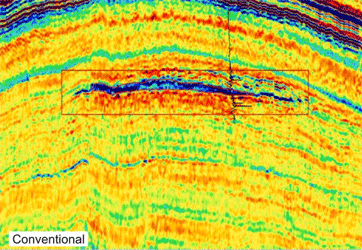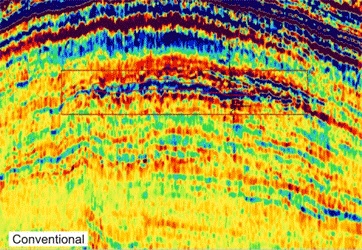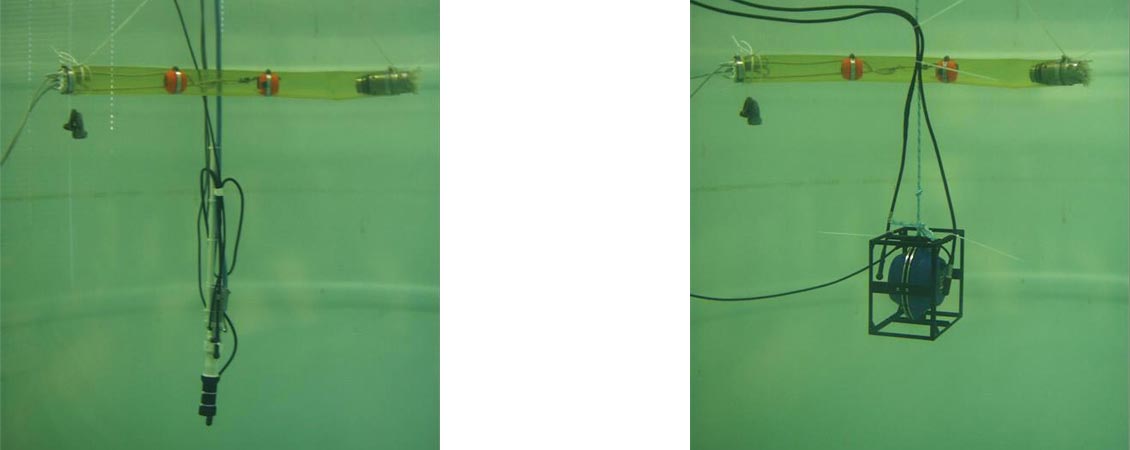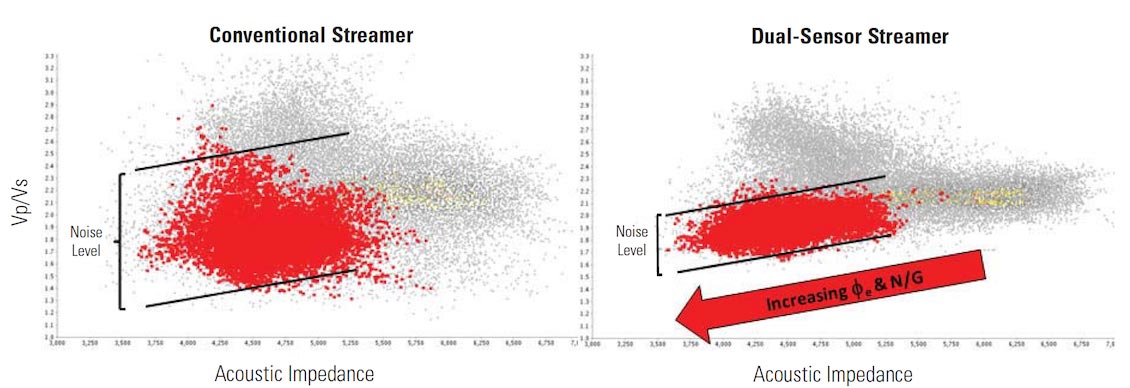“For a successful technology, reality must take precedence over public relations, for Nature cannot be fooled” – Richard P. Feynman, Nobel Prize in Physics, 1965
 Acoustic impedance (see below for a full description)In many ways, finding a cure for the marine seismic ghost has been the holy grail for geophysical researchers. Ghost elimination has been a problem that everyone has known about and wanted to solve. The ghost kills most of the low frequencies and provides notches in the spectrum, thus having a deleterious effect on the seismic wavefield. But, as we explained in the previous articles in this series (links provided at the end of this article), if one could have motion sensors together with hydrophones in the towed streamer, one can exorcize the ghosts.
Acoustic impedance (see below for a full description)In many ways, finding a cure for the marine seismic ghost has been the holy grail for geophysical researchers. Ghost elimination has been a problem that everyone has known about and wanted to solve. The ghost kills most of the low frequencies and provides notches in the spectrum, thus having a deleterious effect on the seismic wavefield. But, as we explained in the previous articles in this series (links provided at the end of this article), if one could have motion sensors together with hydrophones in the towed streamer, one can exorcize the ghosts.
Rune Tenghamn and Svein Vaage from PGS, assisted by their colleagues Audun Sødal, Claes Borresen and Andre Stenzel, took on the challenge in the early 2000s.
Curious – and Optimistic
 Vp/Vs ratio (see below for a full description)For Rune it started at a conference 13 years ago, where he heard about Navy trials on using motion sensors in a towed array. When he came back to the office, he discussed it with his colleagues and suggested they should try it out. No one really believed it was possible. Several challenges were seen. Firstly, it would not be easy to maintain the many thousands of particle motion sensors in the streamer in the proper orientation to detect vertical motion. Secondly, due to the noise level in the streamer cables, motion sensors in streamers were regarded as having limited utility. In particular, the mechanical vibrations in the cable were known to produce high noise levels in geophone signals at low frequencies.
Vp/Vs ratio (see below for a full description)For Rune it started at a conference 13 years ago, where he heard about Navy trials on using motion sensors in a towed array. When he came back to the office, he discussed it with his colleagues and suggested they should try it out. No one really believed it was possible. Several challenges were seen. Firstly, it would not be easy to maintain the many thousands of particle motion sensors in the streamer in the proper orientation to detect vertical motion. Secondly, due to the noise level in the streamer cables, motion sensors in streamers were regarded as having limited utility. In particular, the mechanical vibrations in the cable were known to produce high noise levels in geophone signals at low frequencies.
Rune was nevertheless curious and optimistic, and saw different pieces coming together. In the past, PGS had worked a lot with ocean bottom sensor systems which contained hydrophones that could sense pressure alongside geophones that detected particle motion. These stationary systems succeeded in the tranquility of the ocean bed where there were no vibrations. Developing a towed streamer system to work in the dynamic environment near the sea surface was a very different and difficult mission.
The first test was with a short streamer section in a test tank at PGS’ research lab in Houston. Using a small source, they studied how the system worked but did not get very good results, although the experiment showed promise. Early 2001, they did a second test in the Gulf of Mexico outside Galveston. Due to high currents, the data were disappointingly noisy; it did not look like a breakthrough. But spending a weekend to analyze the frequency spectra of the data, Rune saw that the data for the higher frequencies of the recordings were fantastic. Encouraged by the results, a patent was filed in August 2002 (US 2004/0042341). The patent also discussed, we note, the possibility of using three component geophones to sense motion in both vertical, inline and crossline directions. That would enable the direction of the incoming signal to be detected, and enable the identification of strumming and other mechanical behavior to the cable.
Inspired by the Galveston test, PGS decided to continue the work. More challenges lay ahead.
A Clever Solution
For the very low frequencies, noise induced by vibrations in the streamer was significantly present. Svein entered the scene, and soon came up with an elegant solution. He suggested simply estimating from the hydrophone signal what the ideal geophone recording should be for the low frequency part of the signal. This principle, which is described in GEO ExPro, Vol. 10, No. 2, is a deghosting-ghosting solution which has been proven to work astonishingly well. The hydrophone recording for the low frequency part of the signal is first effectively deghosted, a process which is not very sensitive to the state of the sea surface and/or possible moderate errors in measured receiver depth. Secondly, the deghosted pressure is multiplied by the geophone ghost. The resulting calculated low-frequency geophone response is then merged with the non-noisy measured geophone recording for the higher frequencies. Finally, the two broad bandwidth signals of pressure and particle motion can be combined into deghosting. This method was filed as a patent in March 2004 (US 2005/0195686). It was a really clever cure to the holy grail problem that no one had ever thought of before, even though the necessary elements of theory were in place (see Amundsen, 1995, and references therein).
Next, special sections containing sensors for velocity measurements were installed in conventional streamers. In the period 2001-2004 the tests showed encouraging results, and in 2004 PGS built the first GeoStreamer, 2,500m long. Prior to the commercial launch of the new streamer concept, two other prototype streamers of 6,000m length were built and tested. In 2007, the PGS development team concluded that they had reached their overall goal: to develop a streamer that measured both pressure and particle velocity with an acceptable noise level.
The journey from the early test experiments in Houston in 2000 ended in 2007 with the successful commercial introduction of the new system. Taking the GeoStreamer from idea and prototype to a robust, reliable, seaworthy commercialized product was a dream come true.
Today, practically all vessels operated by PGS are equipped with GeoStreamers. In the six years since the GeoStreamer solution was launched, service company competitors have launched a diverse family of broadband solutions. More recently, industry attention is also turning to broadband source solutions so that the source ghost can be attacked.
Rock ‘n’ Fluid
The ability to predict reservoir properties from seismic data is crucial in reservoir characterization. The accuracy of the reservoir property prediction is improved by having more low frequency seismic information and less a priori (well) information included in the process.
With extended seismic low frequency content, the dependency on any well information will become increasingly less important. Increased high frequencies provide better vertical seismic resolution throughout the available depth range and more importantly at the reservoir level, allowing reservoir geoscientists to see as much detail as possible.
As an example, we have data which were acquired in the North West Australian Shelf of the Carnarvon Basin with both conventional and dual-sensor streamer technology. This area is a world-class gas province with minor oily sweet spots in the Permo-Triassic sediments, overlain by Jurassic to Cenozoic syn and post rift successions
The figures and caption above, taken from PGS TechLink, March 2011, present the result of a relative acoustic inversion study using both conventional and dual-sensor streamer data. A relative inversion (inversion without any low frequency or a priori model) was chosen to avoid any bias from well information, so the inversion results represent only the seismic contribution. The dual-sensor streamer provides a clearer acoustic impedance image (left) observed in the following aspects: definition of the flat-spot is greatly improved (arrow A), the top and base of the reservoir is more clearly defined (arrow B) and improved delineation of the geo-bodies (arrow C). From a seismic inversion point of view, one should expect to retrieve the layering of the earth (removal of the wavelet effect) and this is better achieved with the dual-sensor streamer technology as opposed to the conventional streamer which looks more like the seismic. It is always a challenge to estimate the Vp/ Vs-ratio directly from streamer data, shown to the right in the figure. Also for the Vp/Vs inversion results we observe a clearer and more precise definition of the reservoir sand as well as of the overlaying shale layer.
Both simultaneous inversions were carried out using exactly the same parameters except for the wavelet (narrower frequency bandwidth for the conventional seismic and broader wavelet for the GeoStreamer dataset), same low frequency model and inversion parameters. Therefore the only differences between the two datasets are simply due to the type of towed streamer. The dual-sensor seismic inversion results exhibit a clearer definition of the individual geological layers and the fluid contact.
To further extend the analysis between the two datasets, a cross-plot was done over the area enclosed in white in the figure above. This area includes the gas reservoir and should therefore have an unambiguous elastic attribute response, with the gas having both lower acoustic impedance and lower Vp/Vs-ratio as seen in the figure above. The cross-plot demonstrates clearly the better stability and lower noise in the pre-stack domain of the elastic reservoir properties, especially in the Vp/Vs-ratio using the dual-sensor streamer acquisition system compared to the conventional data.
The extended bandwidth, especially at the low frequency end of the spectrum, thus represents a key improvement in lithology-fluid prediction and also in seismic reservoir property estimation. The need for a priori information is considerably reduced by relying more on the data and less on a low frequency background model compared with a conventional seismic streamer.
Today, almost all vessels operated by PGS are equipped with GeoStreamers, including their Ramform fleet. Source: PGSReferences
- Amundsen L., B. G. Secrest and B. Arntsen, 1995. Extraction of the normal component of the particle velocity from marine pressure data: Geophysics 60 212–222.
- Tenghamn R., S. Vaage and C. Borresen, 2007. A dual-sensor towed marine streamer: Its viable implementation and initial results: SEG Expanded Abstracts 989–993.
- PGS TechLink March 2011









